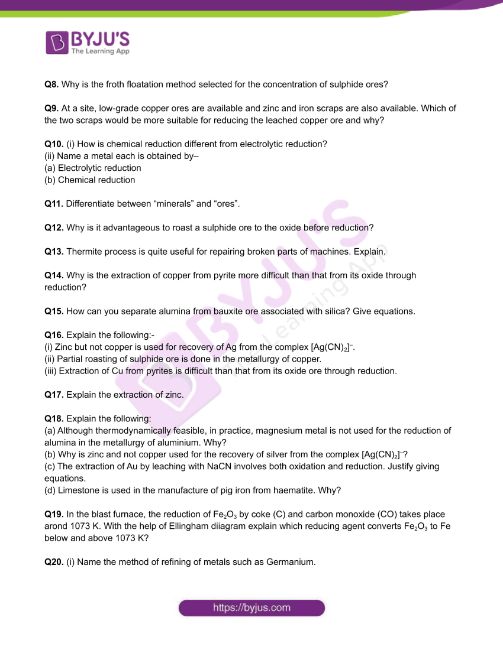Metallurgy is the extraction of pure metals from their ores. Metals are extracted from their ores using reactivity-based methods. Electrolysis is used to extract highly reactive metals from ores, whereas calcination, roasting, and reduction methods are used to extract medium reactivity metals. While roasting and refining are used to extract low-reactivity metals from their ores. Although the majority of low reactive metals, such as gold, are found in their free form or in combination with silver and mercury (As amalgam). Prior to using any of these metal extraction methods based on reactivity, ores must be concentrated. In nature, ore is found with a variety of impurities such as rock particles, sand, and other impurities. These impurities in an ore are known as matrix or gauge impurities. Concentration ore refers to the removal of a matrix or gauge from the ore.
Download Class 12 Chemistry Worksheet Chapter 6 General Principles and Processes of Isolation of Elements PDF – Set 4
CBSE Class 12 Chemistry Chapter 6 General Principles and Processes of Isolation of Elements Worksheet – Set 4
Q1. The first step in the extraction of copper from copper pyrites is-
a.) reduction by carbon.
b.) electrolysis of ore
c.) roasting of ore in O2
d.) magnetic separation
Q2. The common impurity present in bauxite is-
a.) CuO
b.) ZnO
c.) Fe2O3
d.) Cr2O3
Q3. Which of the following ore is best concentrated by froth floatation method?
a.) Magnetite
b.) Siderite
c.) Galena
d.) Malachite
Q4. Which of the following is a mineral of iron?
a.) Malachite
b.) Cassiterite
c.) Pyrolusite
d.) Magnetite
Q5. Which of the following ore is concentrated by chemical leaching method?
a.) Argentite
b.) Galena
c.) Copper glance
d.) Cinnabar
Q6. What is gravity separation?
Q7. What is cupellation?
Q8. Why is the froth floatation method selected for the concentration of sulphide ores?
Q9. At a site, low-grade copper ores are available and zinc and iron scraps are also available. Which of the two scraps would be more suitable for reducing the leached copper ore and why?
Q10. (i) How is chemical reduction different from electrolytic reduction?
(ii) Name a metal each is obtained by–
(a) Electrolytic reduction
(b) Chemical reduction
Q11. Differentiate between “minerals” and “ores”.
Q12. Why is it advantageous to roast a sulphide ore to the oxide before reduction?
Q13. Thermite process is quite useful for repairing broken parts of machines. Explain.
Q14. Why is the extraction of copper from pyrite more difficult than that from its oxide through reduction?
Q15. How can you separate alumina from bauxite ore associated with silica? Give equations.
Q16. Explain the following:-
(i) Zinc but not copper is used for recovery of Ag from the complex [Ag(CN)2]–.
(ii) Partial roasting of sulphide ore is done in the metallurgy of copper.
(iii) Extraction of Cu from pyrites is difficult than that from its oxide ore through reduction.
Q17. Explain the extraction of zinc.
Q18. Explain the following:
(a) Although thermodynamically feasible, in practice, magnesium metal is not used for the reduction of alumina in the metallurgy of aluminium. Why?
(b) Why is zinc and not copper used for the recovery of silver from the complex [Ag(CN)2]–?
(c) The extraction of Au by leaching with NaCN involves both oxidation and reduction. Justify giving equations.
(d) Limestone is used in the manufacture of pig iron from haematite. Why?
Q19. In the blast furnace, the reduction of Fe2O3 by coke (C) and carbon monoxide (CO) takes place arond 1073 K. With the help of Ellingham diiagram explain which reducing agent converts Fe2O3 to Fe below and above 1073 K?
Q20. (i) Name the method of refining of metals such as Germanium.
(ii) In the extraction of Al, impure Al2O3 is dissolved in conc. NaOH to form sodium aluminate and leaving impurities behind. What is the name of this process?
(iii) What is the role of coke in the extraction of iron from its oxides?
Download PDF to access answers of Chemistry Worksheet for Class 12 Chemistry Chapter 6 General Principles and Processes of Isolation of Elements set – 4.
Download PDF
Read Also:
- General Principles and Processes of Isolation of Elements Class 12 Notes Chapter 6
- General principles and Processes of Isolation of Elements MCQs
- NCERT Solutions for Class 12 Chemistry Chapter 6 General Principles and Processes of Isolation of Elements
- Important Questions for Class 12 Chemistry Chapter 6 – General Principles and Processes of Isolation of Elements




Comments